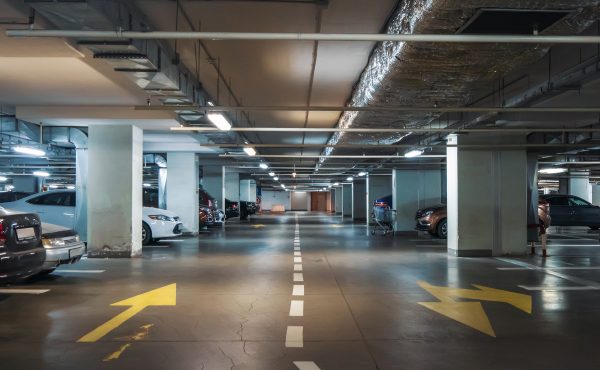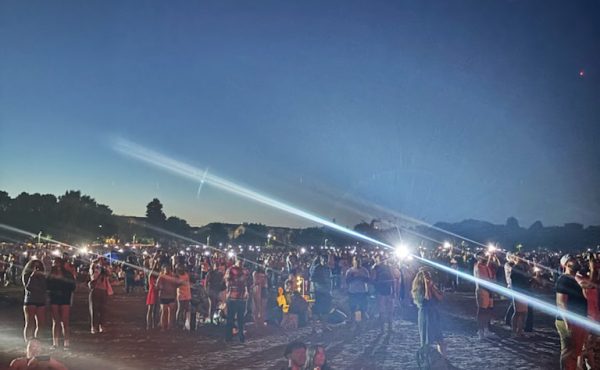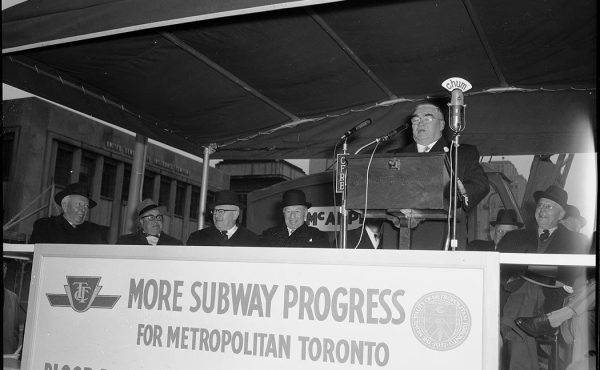

To escape the long shadow cast by Canada Day, this edition of Throwback Thursday jumps to July 3rd (tomorrow), when in 1965 the first subway train crossed the Don Valley on the lower deck of the Bloor Street Viaduct.
Completed in 1918, the Don Valley Phase of the Prince Edward Viaduct has garnered a lot of popular attention in the past couple decades. Beginning with its role in Michael Ondaatje’s In the Skin of a Lion in 1987, the growing awareness in 1997 of the many suicides occurring on the viaduct (ranked as the second most fatal standing structure in the world with over 400 suicides, or an average of one suicide every 22 days in 1997), the award-winning Luminous Veil suicide barrier that was installed in 2003 and the recent release of many of Arthur Goss’ photos taken for the City, the Viaduct has become one of the landmarks frequently associated with Toronto.
Yet little recognition has been given to the original structural features of the viaduct. For although the then commissioner of public works R.C. Harris is well known for his many achievements around the city – the water filtration plant that goes by his name – not much has been said in regards to his foresight in pushing for a lower deck on the Viaduct that might one day accommodate a subway.
Designed by architect Edmund Burke and engineered by Thomas Taylor, the only work needing to be done in order to have a subway run through the Viaduct over forty years after it was built was to lay down reinforced concrete on the lower deck to serve as a trackbed for the train.
Besides R.C. Harris, credit is also due to the New York City consulting firm Jacobs and Davies, whose engineering report in 1910 recommended provisions for a future subway system which, at the time, were beginning to be built in cities all over the world. Although it was an expensive addition to the Viaduct, which ended up costing a total of $2.5 million ($ in 1918), it saved at least $10 million 47 years later in the building of the Bloor-Danforth subway line.
While there was also a lower deck built below the Rosedale Ravine Phase of the Prince Edward Viaduct, it was deemed too sharp of a curve for a subway to navigate and therefore the Rosedale bridge was built for the subway to use at Castle Frank station.
Although I am only speculating, I wonder to what extent – if any – the Viaduct’s lower deck helped to propel a subway getting built along Bloor Street rather than Queen Street, as many in the city had wanted and some continue to want? Although the TTC was then financially independent from City Hall, the 1621 foot bridge would none-the-less have significantly reduced the cost of building a line strictly under Bloor-Danforth rather than a U-shape which would partially run under Queen St.
But then again, it may not have factored in at all. Your thoughts?
Photos from Jenifa taught me and the Toronto Archives (fonds 1231, file 1231, item 0040)





15 comments
The Bloor Viaduct has long been my favourite piece of infrastructure anywhere in the world precisely because its builders thought to include provision for a subway that would not be built for another fifty years. What forethought our forbearers must have had to build such a bridge! Their ability to think fifty years into the future makes our inability to address today’s pressing infrastructure needs all the more pathetic and depressing.
I love the viaduct because of the subway provision – so logical and smart. I am curious about how easy it was to get it to pass back in the day. How much squabbling took place, and how long did it take to reach approval?
Sadly, could something like this happen in the present? I doubt it.
Hopefully when they build the Eglinton LRT tunnels that have the foresight to build them to support a subway in the future.
No problem ‘Vivek’, the politicians are arguing about the streetcars that should have been built 30y in the past.
A lot of bridges nowadays have no provision for transit of any kind. And now they even ignore past disasters, such as Hurricane Hazel. There was, until graffiti covered it, a high water mark on the Bloor bridge over the Humber River, which seemed to be close to the same level as the subway bridge over the Humber.
Unfortunately, with all the roads, parking lots, and buildings built since Hurricane Hazel, if the same rainfall should occur (with a wet October prior to that storm) there would be a HIGHER river level. All that runoff will not be stored in the ground, but drained quickly off roofs, roads, and parking lots, possibly creating more damage.
In case anyone else is curious: according to the bank of Canada’s inflation calculator, $2.5 million in 1918 dollars was worth about $4.8M in 1965 dollars, and about $33M in today’s dollars.
I can think of another bit of infrastructure built recently which shows just as much forethought: the Sheppard subway line. It’s probably at least 50 years ahead of its time in terms of demand. But it might also prove to be cheaper than building an intermediate system and then the subway in the future.
As one of the designers of the suicide barrier, I’ve always had a soft spot for this bridge. Sorry that the veil didn’t come out quite as light as we originally wanted — costs and the difficulties of controlling lateral deflection in a tensile member to the limits desired by the suicide-prevention backers made the top piece too bulky in the end and swapped the screen of wires into rigid rods. Did the city ever add lighting the way it was originally intended? The greatly reduced costs of LED’s today could finally make possible the ribbon of light at the top member to illuminate the screen at night, which would finally put the Luminous into Luminous Veil.
Back on topic, here are some NYC examples of infrastructure built with foresight:
George Washington Bridge — world’s longest suspension bridge when it opened in 1931, it was designed from the start to eventually hold a second deck. When the deck was added thirty years later it allowed the bridge to go from 8 lanes to 14, avoiding the need for another costly bridge or tunnel.
Henry Hudson Bridge — part of Robert Moses’ auto-fantasia, the bridge needed two decks to match up with the adjacent new parkway. However, the financiers never thought anyone would pay a toll to use a highway when there was a free (if gridlocked) bridge nearby so Moses cleverly cut costs by building only one deck while engineering the arch to support the second. Turns out people liked cars and speed after all, and only two years later the second deck was added at minimal cost.
63rd St Tunnel — built for a subway line in the 1960s, the planners figured that they had better add a lower level in case the commuter trains (LIRR) ever wanted to go to Grand Central. Fifty years later, that event will finally happen.
Without a doubt the viaduct was a brilliant piece of engineering foresight and planning aplomb. And at the risk of rekindling the Queen Subway debate, it’s not hard to see why so many people support it, with a similar sense of foresight as the viaduct’s designers. Yonge/Bloor is the lynchpin of the current subway system and my understanding is that it’s at or near capacity during rush hours. Meanwhile urban intensification continues in Toronto. So unless we build a ROW down Queen, we’ll need an additional subway line once the transit city projects are done. And yes, it won’t be cheap. But, realistically, a return to $150+ barrels of crude could very well prove the tipping point.
Let’s get those forward thinking city building people out of their suspended animation pods and get them running our city. We surely need them.
Interesting about the Luminous veil design and the City’s unfortunate cost cuts.
I want to applaud the thoughts of the designers, and the good intentions of those seeking to reduce suicides; but I must admit to not liking the structure as constructed.
I loved the original viaduct, for the most part; and the views it afforded. The veil has had an unfortunate impact and is incongruous to the historical aspects of the bridge, while not being particularly beautiful in contrast. Perhaps had the original material palate been followed, and the lighting installed, I would feel different. Apologies to USkyscraper, whose thoughtful contributions here and on UT I often enjoy.
While we’re on about the design of this thing, could we please fix the hideous high-mast stainless steet streetlights with the awful HPS (orange) glow!
***
Back to the strict topic, I don’t know if the viaduct’s design had a material impact on the proposed subway route. It seems to me, though perhaps I am incorrect, that the Bloor-Danforth streetcar was the City’s busiest at the time of the subway’s construction; certainly it was very busy.
I’m sure that played a large role in where the subway went.
It probably didn’t hurt that expropriation was probably cheaper and less controversial near Bloor-Danforth than Queen, particularly near the outer parts of the line.
I’m wondering how much the decision to include a transit deck related to examples elsewhere–for instance, the Detroit-Superior Bridge in Cleveland
http://en.wikipedia.org/wiki/Detroit-Superior_Bridge
Thank you Kevin.
And re the Rosedale Valley part of the Viaduct: considering that the angle it takes prefigured a diagonal artery (a fashionable concept among City Beautiful-era urban planners), I’m wondering what the likelihood might have been of a subway taking *that* kind of route–thus, perhaps, negating the Bloor vs Queen question…
@ Paul: I came into the comments to post the $32.9m 2009 dollars figure (this would buy 5 or 6 wave decks!)
Amazing how cheap labour must have been at the time compared to today… not that labour standards circa 1918 were much to write home about… but I digress.